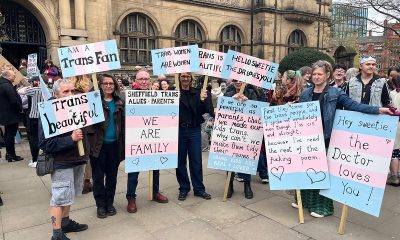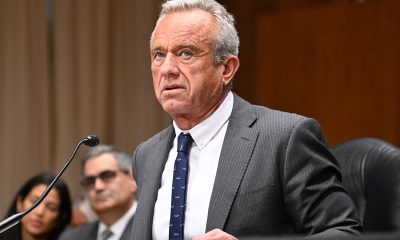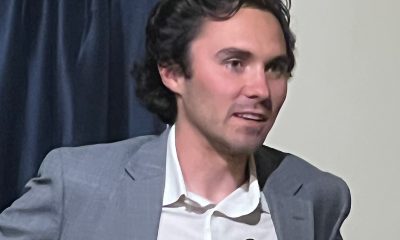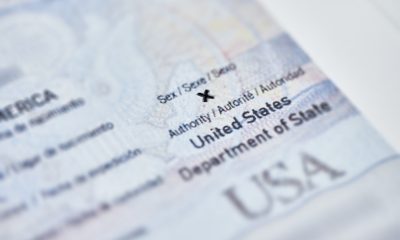National
Gay Ukrainian immigrant looked to social media to find himself
Artem Bezrukavenko was born in Donetsk
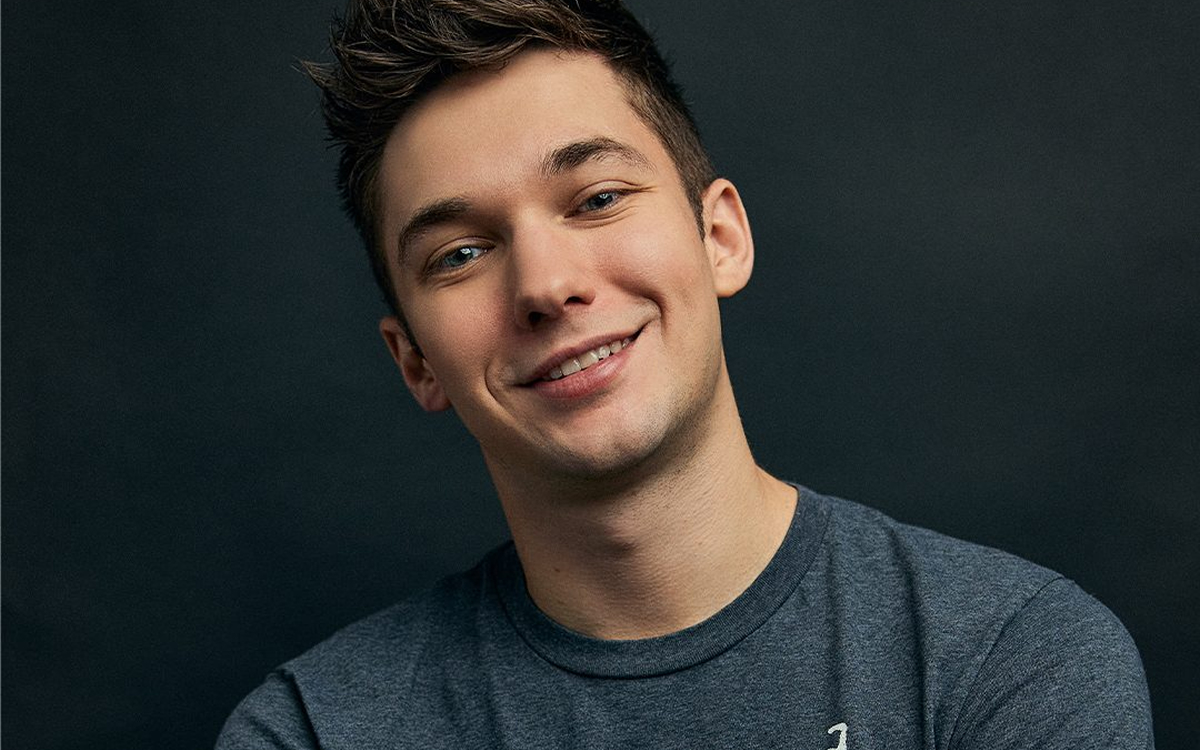
On the streets of New York City, Artem Bezrukavenko stood next to a bystander with a microphone.
“What would be your ideal boyfriend?” he asked the man.
But he didn’t answer. Instead, he posed the same question to Bezrukavenko.
“My ideal boyfriend would be loyal, ambitious and monogamous,” Bezrukavenko said, adding: “He knows what he wants from life, loves me — I love him — and we have very good goals that are going to bring us together.”
Of course, Bezrukavenko has already found this man. He and his boyfriend have been together for over a year and share a one bedroom apartment in the Upper West Side.
But it hasn’t always been this way for Bezrukavenko. The 25-year-old, who was born in the Donetsk region of eastern Ukraine, left the country for nearby Poland in 2014, the year Russia annexed Crimea from Ukraine — beginning a period of prolonged bloodshed in the country’s Donetsk and Luhansk regions. He moved to the U.S. a few years later, in 2017.
Bezrukavenko told the Los Angeles Blade that he has been closeted most of his life. But, through social media, he said he learned to embrace his queer identity.
“When I started to do content, I didn’t really show my gay side,” he said. “But, at some point, I just kind of dived into it. I saw there were a lot of people who could relate to me. And, in fact, I do change a lot of people’s lives.”
Double-edged sword
Discussions surrounding the LGBTQ community and social media often focus on cyberbullying and hate speech. However, some research has shown that the internet can also provide LGBTQ people, particularly youth, a safe space to explore themselves — especially if they come from an unsupportive environment.
According to a study published in the Journal of Medical Internet Research, sexual minorities between 10 and 16 years old more often reported joining a group or web-based community to make themselves feel less alone compared to their heterosexual peers. An Australian survey of people aged 14-21 found digital spaces provide an ideal practice ground for LGBTQ youth to come out, engage with gay culture, socialize with other LGBTQ youth and experiment with non-heterosexual intimacy.
Ross Murray, vice president of the GLAAD Media Institute, said LGBTQ people often use social media to find people like them. He said it can be very easy to feel isolated, but “social media helps you find and realize that you’re not alone.”
On the flip side, Murray said, social media is also used to broadcast who you are. “You can be the one who is sharing your life, being your authentic self, talking about the joys and struggles, so that other LGBTQ people can learn that,” he said.
Bezrukavenko has seen both sides — inspired by LGBTQ creators and empowered by making content that celebrates who he is.
“I looked at some people who were being gay on social media and showing their life,” he said. “I felt like, ‘oh, my gosh, there are so many gay people.’ And they’re not feeling it’s a disadvantage, they make the best out of it.”
That’s not to say social media isn’t an increasingly dangerous place for LGBTQ people. GLAAD, for example, recently analyzed the five major social media platforms – Facebook, Instagram, Twitter, YouTube and TikTok — finding none scored over a 50 percent for LGBTQ safety, privacy and expression. TikTok — the second most popular form of social media amongst teens, according to Pew Research — scored the lowest, with 43 percent.
“This is the dark side of visibility, I guess,” Murray said. “The more visible you get, the more of a target you become.”
Murray said social media is a place where we put ourselves out there. We do it for an intended audience, he said, like people we can educate, comfort or guide. “But that can be seen by anyone,” he said. “And that being seen by anyone also then can turn into a weaponization.”
Bezrukavenko — who dabbled with, but ultimately abandoned, social media before coming out — said fear of online harassment kept him from pursuing it for most of his life. He said he always wanted to do social media, but his biggest fear was that he would be bullied for how he talked or walked, like in school.
War in Ukraine
His life changed drastically in 2014 as war erupted 80 miles from his home in the Ukrainian city of Dobropillya. Bezrukavenko, who was raised by his mother and grandparents, was 17 at the time and had just finished high school.
In an attempt to salvage his country’s lost influence in Ukraine, Russian President Vladimir Putin invaded and annexed Crimea on the northern coast of the Black Sea in March 2014. Then, pro-Russia separatist rebels began seizing territory in the eastern part of the country. But as fighting with the Ukrainian military intensified, the rebels started losing — causing Russia to invade eastern Ukraine in August 2014. As of September 2014, more than 2,500 Ukrainians have been killed.
Bezrukavenko wanted to build a life for himself. Not only was there war, but he also said he knew he was gay and — though he saw the country making some efforts toward LGBTQ tolerance — ultimately didn’t see Ukraine as a place where he would be comfortable.
“I knew I did not belong in Ukraine, and I always wanted to go away,” he said.
Bezrukavenko said his Ukranian identity is complicated — he hasn’t felt a strong connection to the country since he left it in 2014. Even with today’s war in Ukraine, he still doesn’t feel a strong sense of Ukrainian identity.
In February of this year, Putin announced a “special military operation” in the country — the war still has no end in sight. Nearly 8 million Ukrainians have fled the country since Russia’s invasion, making it the worst refugee crisis in Europe since World War II. Russia has also been accused of war crimes.
Bezrukavenko still has family in Ukraine. In fact, his uncle is fighting in the war. “I don’t really miss Ukraine, and I don’t really want to live there,” he said. “But I don’t want them to be under the bumps.”
Bezrukavenko said he thinks his sense of Ukrainian identity has faded because he moved from the country at a young age. He said since moving to America, the feeling has faded even more.
“My whole adult life, I was out of there, so I feel like I’m probably more American than Ukrainian at this point,” he said.
Bezrukavenko’s journey
So he could leave the country, Bezrukavenko’s family — who he was not out — borrowed money and sent him to Warsaw with a three-month allowance. Knowing little Polish, he was set to start at the University of Management.
He said he had to “hustle” in Poland. In addition to school, Bezrukavenko worked two jobs at a time – working for months without a day off. At one point, he was expelled from school for poor attendance. (He was later readmitted.)
“I didn’t have a choice,” he said. “It’s not like I didn’t want to go to school, I just didn’t have time.”
After six months of being in Warsaw, Bezrukavenko’s mother joined him. They shared a small studio apartment with nothing to sleep on but a small couch. He worked during the day while his mother worked nights.
“There was no time for anything,” he said. “It was just working.”
Bezrukavenko worked several jobs in Warsaw — from distributing flyers to being a receptionist and sales associate. “You know, it sounds terrible but it was a good time,” he said.” I had a dream and I was saving money for America.”
After three years in Poland — with only $500 in his pocket — Bezrukavenko moved to the U.S. in 2017. His mother stayed back in Warsaw.
In the years since, Bezrukavenko has moved coast to — starting his journey in Ocean City, Md., then New York City (for one day), then Chicago, then Los Angeles, then Austin, until he ended up in Manhattan.
“I did a circle kind of,” he said.
All the while, he worked in restaurants, call centers and retail — to name a few — to make ends meet.
Coming out — twice
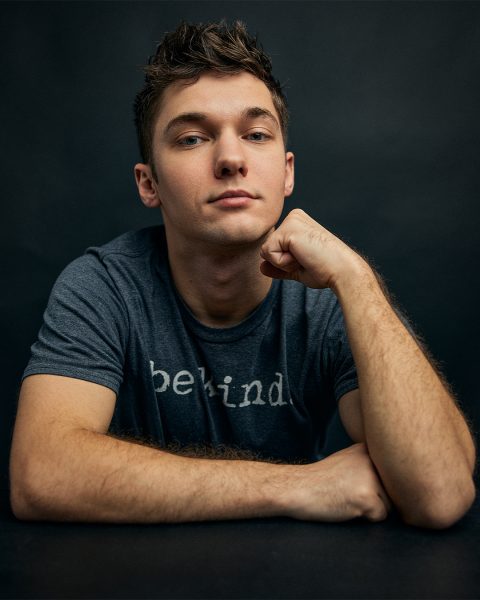
During this period, Bezrukavenko was closeted. While living in Warsaw, he remembers telling his mother he was gay. She suggested that a psychologist could help him.
“Even though my mom is the most progressive mom ever — I mean, she was my best friend all my life. But she still couldn’t believe that I was gay,” Bezrukavenko said. “So we kind of forgot about it.”
After having his heart broken in Austin — though he said it “wasn’t really that broken, I was just being [dramatic]” — Bezrukavenko came out to his mother again. This time went smoother than the last.
“After I came out to my mom, I was just like, I just need to come out — I just need to get it over with,” he said.
Bezrukavenko publicly came out as gay in a video posted on Christmas 2020 while living in Austin. In it, he held the LGBTQ Pride flag over his shoulders. Within three hours, the video had 500,000 views.
“I thought in my head, I make a problem for myself being gay,” he said. “Why don’t I look at it as not a problem but an advantage?”
He said that his life changed a lot after posting that video, something that shocked him. He began to grow on all different platforms — like TikTok, Instagram and YouTube — sharing his story, doing LGBTQ-themed videos, posting so-called “thirst traps” and doing comedy.
Bezrukavenko also noticed that many people online were already saying he was gay. For example, he said he ran a YouTube channel in Polish about living in America while he was closeted. As the channel grew, so did the number of people saying he acted gay — which, at the time, made him feel ashamed.
“They would say I am giving Cher,” he said, referring to a viral Shawn Mendes video, where the singer told his then-girlfriend Camila Cabello that “it’s giving Cher.” The meme invited inappropriate jokes about Mendes’ presumed sexuality.
But as it turned out, Bezrukavenko said, being unapologetically himself on the internet set him free and racked up more views.
“I realized at this point, why do I hide myself?” he said. “I have a very unique perspective.”
Gay content for gay people
Now, Bezrukavenko is living in Manhattan with his boyfriend, mainly creating content on TikTok, Instagram and OnlyFans.
Bezrukavenko recently teamed up with a fellow gay influencer, StanChris, to film a series of videos later seen on TikTok and Instagram.
“He seems really, really motivated — and I really liked that,” Chris, who asked the Blade to use his first name only, said. “He’s like, go, go, let’s work. And he’s always thinking of new ideas and stuff.”
The two met after Chris noticed a viral Instagram reel Bezrukavenko posted. When Chris clicked on the account, he noticed Bezrukavenko had already attempted to DM him. So he wrote back, and the two began communicating.
Chris, who lives in New Hampshire, was in New York for a skateboarding event and suggested that the two meet in person to film videos. After spending some time in Bezrukavenko’s apartment, the two embarked on a night in the city.
“We were just interviewing random people, asking them questions for more short videos to make,” Chris said. “And we both got multiple viral videos from doing that, so we had some good energy, good vibes, good luck.”
Bezrukavenko said he is focusing on making gay content for gay people. “I realized at some point that there is not enough gay content — that there is not enough good representation,” he said.
He does have one account, Art in the Park — a TikTok page with over 120,000 followers and north of 3 million likes where he interviews people on the streets of New York City — with the purpose of capturing a wider audience. Though he has come to love interviewing people, he said he is also focused on his LGBTQ-themed comedy on his personal accounts.
Bezrukavenko said his life is the most stable it’s ever been. After losing both his grandparents last year, he met his now boyfriend.
“I don’t want to say I’m a religious person, but I feel like there’s some power,” he said. “I told my mom a lot that I feel like [my boyfriend] was sent to me by my grandparents.”
He described his personal life as “very boring because it’s very good.”
Federal Government
HHS to retire 988 crisis lifeline for LGBTQ youth
Trevor Project warns the move will ‘put their lives at risk’

The U.S. Department of Health and Human Services is planning to retire the national 988 crisis lifeline for LGBTQ youth on Oct. 1, according to a preliminary budget document obtained by the Washington Post.
Introduced during the Biden-Harris administration in 2022, the hotline connects callers with counselors who are trained to work with this population, who are four times likelier to attempt suicide than their cisgender or heterosexual counterparts.
“Suicide prevention is about risk, not identity,” said Jaymes Black, CEO of the Trevor Project, which provides emergency crisis support for LGBTQ youth and has contracted with HHS to take calls routed through 988.
“Ending the 988 Suicide and Crisis Lifeline’s LGBTQ+ youth specialized services will not just strip away access from millions of LGBTQ+ kids and teens — it will put their lives at risk,” they said in a statement. “These programs were implemented to address a proven, unprecedented, and ongoing mental health crisis among our nation’s young people with strong bipartisan support in Congress and signed into law by President Trump himself.”
“I want to be clear to all LGBTQ+ young people: This news, while upsetting, is not final,” Black said. “And regardless of federal funding shifts, the Trevor Project remains available 24/7 for anyone who needs us, just as we always have.”
The service for LGBTQ youth has received 1.3 million calls, texts, or chats since its debut, with an average of 2,100 contacts per day in February.
“I worry deeply that we will see more LGBTQ young people reach a crisis state and not have anyone there to help them through that,” said Janson Wu, director of advocacy and government affairs at the Trevor Project. “I worry that LGBTQ young people will reach out to 988 and not receive a compassionate and welcoming voice on the other end — and that will only deepen their crisis.”
Under Trump’s HHS secretary, Robert F. Kennedy, Jr., the agency’s departments and divisions have experienced drastic cuts, with a planned reduction in force of 20,000 full-time employees. The Substance Abuse and Mental Health Services Administration has been sunset and mental health services consolidated into the newly formed Administration for a Healthy America.
The budget document reveals, per Mother Jones, “further sweeping cuts to HHS, including a 40 percent budget cut to the National Institutes of Health; elimination of funding for Head Start, the early childhood education program for low-income families; and a 44 percent funding cut to the Centers for Disease Control, including all the agency’s chronic disease programs.”
U.S. Supreme Court
Supreme Court hears oral arguments in LGBTQ education case
Mahmoud v. Taylor plaintiffs argue for right to opt-out of LGBTQ inclusive lessons

The U.S. Supreme Court on Tuesday heard oral arguments in Mahmoud v. Taylor, a case about whether Montgomery County, Md., public schools violated the First Amendment rights of parents by not providing them an opportunity to opt their children out of reading storybooks that were part of an LGBTQ-inclusive literacy curriculum.
The school district voted in early 2022 to allow books featuring LGBTQ characters in elementary school language arts classes. When the county announced that parents would not be able to excuse their kids from these lessons, they sued on the grounds that their freedom to exercise the teachings of their Muslim, Jewish, and Christian faiths had been infringed.
The lower federal courts declined to compel the district to temporarily provide advance notice and an opportunity to opt-out of the LGBTQ inclusive curricula, and the 4th U.S. Circuit Court of Appeals determined that the parents had not shown that exposure to the storybooks compelled them to violate their religion.
“LGBTQ+ stories matter,” Human Rights Campaign President Kelley Robinson said in a statement Tuesday. “They matter so students can see themselves and their families in the books they read — so they can know they’re not alone. And they matter for all students who need to learn about the world around them and understand that while we may all be different, we all deserve to be valued and loved.”
She added, “All students lose when we limit what they can learn, what they can read, and what their teachers can say. The Supreme Court should reject this attempt to silence our educators and ban our stories.”
GLAD Law, NCLR, Family Equality, and COLAGE submitted a 40-page amicus brief on April 9, which argued the storybooks “fit squarely” within the district’s language arts curriculum, the petitioners challenging the materials incorrectly characterized them as “specialized curriculum,” and that their request for a “mandated notice-and-opt-out requirement” threatens “to sweep far more broadly.”
Lambda Legal, the Leadership Conference on Civil and Human Rights, PFLAG, and the National Women’s Law Center announced their submission of a 31-page amicus brief in a press release on April 11.
“All students benefit from a school climate that promotes acceptance and respect,” said Karen Loewy, senior counsel and director of constitutional law practice at Lambda Legal. “Ensuring that students can see themselves in the curriculum and learn about students who are different is critical for creating a positive school environment. This is particularly crucial for LGBTQ+ students and students with LGBTQ+ family members who already face unique challenges.”
The organizations’ brief cited extensive social science research pointing to the benefits of LGBTQ-inclusive instruction like “age-appropriate storybooks featuring diverse families and identities” benefits all students regardless of their identities.
Also weighing in with amici briefs on behalf of Montgomery County Public Schools were the National Education Association, the ACLU, and the American Psychological Association.
Those writing in support of the parents challenging the district’s policy included the Center for American Liberty, the Manhattan Institute, Parents Defending Education, the Alliance Defending Freedom, the Trump-Vance administration’s U.S. Department of Justice, and a coalition of Republican members of Congress.
U.S. Supreme Court
LGBTQ groups: SCOTUS case threatens coverage of preventative services beyond PrEP
Kennedy v. Braidwood oral arguments heard Monday

Following Monday’s oral arguments before the U.S. Supreme Court in Kennedy v. Braidwood Management, Inc., LGBTQ groups issued statements warning the case could imperil coverage for a broad swath of preventative services and medications beyond PrEP, which is used to reduce the risk of transmitting HIV through sex.
Plaintiffs brought the case to challenge a requirement that insurers and group health plans cover the drug regimen, arguing that the mandate “encourage[s] homosexual behavior, intravenous drug use, and sexual activity outside of marriage between one man and one woman.”
The case has been broadened, however, such that cancer screenings, heart disease medications, medications for infants, and several other preventive care services are in jeopardy, according to a press release that GLAAD, Lambda Legal, PrEP4All, Harvard Law’s Center for Health Law and Policy Innovation (CHLPI), and the Center for HIV Law and Policy (CHLP) released on Monday.
The Trump-Vance administration has argued the independent task force responsible for recommending which preventative services must be covered with no cost-sharing for patients is constitutional because the secretary of the U.S. Department of Health and Human Services can exercise veto power and fire members of the volunteer panel of national experts in disease prevention and evidence-based medicine.
While HHS secretaries have not exercised these powers since the Affordable Care Act was passed in 2010, Braidwood could mean Trump’s health secretary, Robert F. Kennedy Jr., takes a leading role in determining which services are included in the coverage mandate.
Roll Call notes the Supreme Court case comes as the administration has suspended grants to organizations that provide care for and research HIV while the ongoing restructuring of HHS has raised questions about whether the “Ending the HIV Epidemic” begun under Trump’s first term will be continued.
“Today’s Supreme Court hearing in the Braidwood case is a pivotal moment for the health and rights of all Americans,” said GLAAD President Sarah Kate Ellis. “This case, rooted in discriminatory objections to medical necessities like PrEP, can undermine efforts to end the HIV epidemic and also jeopardize access to essential services like cancer screenings and heart disease medications, disproportionately affecting LGBTQ people and communities of color.”
She added, “Religious exemptions should not be weaponized to erode healthcare protections and restrict medically necessary, life-saving preventative healthcare for every American.”
Lambda Legal HIV Project Director Jose Abrigo said, “The Braidwood case is about whether science or politics will guide our nation’s public health policy. Allowing ideological or religious objections to override scientific consensus would set a dangerous precedent. Although this case began with an attack on PrEP coverage, a critical HIV prevention tool, it would be a serious mistake to think this only affects LGBTQ people.”
“The real target is one of the pillars of the Affordable Care Act: The preventive services protections,” Abrigo said. “That includes cancer screenings, heart disease prevention, diabetes testing, and more. If the plaintiffs succeed, the consequences will be felt across every community in this country, by anyone who relies on preventive care to stay healthy.”
He continued, “What’s at stake is whether we will uphold the promise of affordable and accessible health care for all or allow a small group of ideologues to dismantle it for everyone. We as a country are only as healthy as our neighbors and an attack on one group’s rights is an attack on all.”
PrEP4All Executive Director Jeremiah Johnson said, “We are hopeful that the justices will maintain ACA protections for PrEP and other preventive services, however, advocates are poised to fight for access no matter the outcome.”
He continued, “Implementing cost-sharing would have an enormous impact on all Americans, including LGBTQ+ individuals. Over 150 million people could suddenly find themselves having to dig deep into already strained household budgets to pay for care that they had previously received for free. Even small amounts of cost sharing lead to drops in access to preventive services.”
“For PrEP, just a $10 increase in the cost of medication doubled PrEP abandonment rates in a 2024 modeling study,” Johnson said. “Loss of PrEP access would be devastating with so much recent progress in reining in new HIV infections in the U.S. This would also be a particularly disappointing time to lose comprehensive coverage for PrEP with a once every six month injectable version set to be approved this summer.”
“Today’s oral arguments in the Braidwood case underscore what is at stake for the health and well-being of millions of Americans,” said CHLPI Clinical Fellow Anu Dairkee. “This case is not just about legal technicalities — it is about whether people across the country will continue to have access to the preventive health services they need, without cost sharing, regardless of who they are or where they come from.”
She continued, “Since the Affordable Care Act’s preventive services provision took effect in 2010, Americans have benefited from a dramatic increase in the use of services that detect disease early, promote healthy living, and reduce long-term health costs. These benefits are rooted in the work of leading scientists and public health experts, including the U.S. Preventive Services Task Force, whose recommendations are based on rigorous, peer-reviewed evidence.”
“Any shift away from cost-free access to preventive care could have wide-ranging implications, potentially limiting access for those who are already navigating economic hardship and health disparities,” Dairkee said. “If Braidwood prevails, the consequences will be felt nationwide. We risk losing access to lifesaving screenings and preventive treatments that have become standard care over the past decade.”
“This case should serve as a wake-up call: Science, not politics, must guide our health care system,” she said. “The health of our nation depends on it.”
“We are grateful for the Justices who steadfastly centered constitutionality and didn’t allow a deadly political agenda to deter them from their job at hand,” said CHLP Staff Attorney Kae Greenberg. “While we won’t know the final decision until June, what we do know now is not having access to a full range of preventative healthcare is deadly for all of us, especially those who live at the intersections of racial, gender and economic injustice.”
“We are crystal clear how the efforts to undermine the ACA, of which this is a very clear attempt, fit part and parcel into an overall agenda to rollback so much of the ways our communities access dignity and justice,” he said. “Although the plaintiffs’ arguments today were cloaked in esoteric legal language, at it’s heart, this case revolves around the Christian Right’s objection to ‘supporting’ those who they do not agree with, and is simply going to result in people dying who would otherwise have lived long lives.”
“This is why CHLP is invested and continues in advocacy with our partners, many of whom are included here,” Greenberg said.

